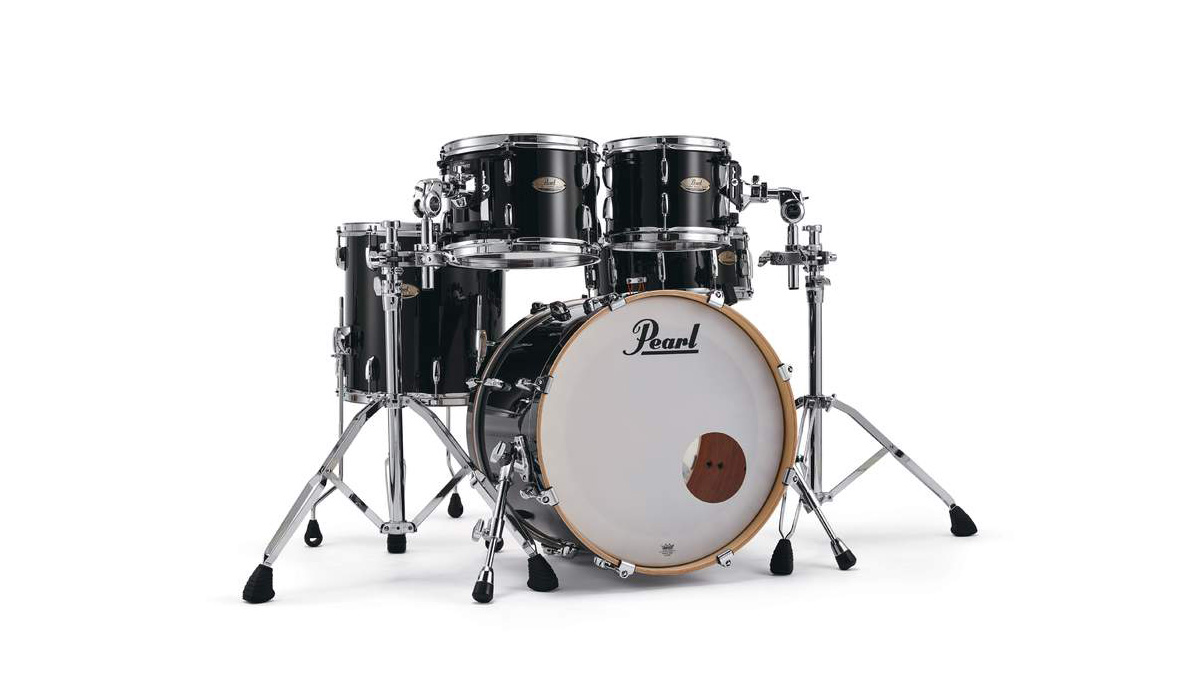MusicRadar Verdict
There’s a lot to like about this kit. With a good range of alternative shellpacks and individual drums to chose from it’s definitely a range to check out.
Pros
- +
Superb shells.
- +
Lots of choice.
Cons
- -
Very few.
MusicRadar's got your back
Thanks to the perennial success of its Export kit - a category of its own as much as a product name - Pearl is a brand new familiar to non-drummers (and even non-musicians) across the world.
Away from the company’s dominance of the entry-level, Pearl caters for every conceivable price point, right up to its bespoke Masterworks series. The Session Studio Select kit on review here pitches head first into the mid-range moshpit with intent.
First launched in 1992, the Session Studio Select series went through various incarnations before being discontinued in 2000. Now, after two years of R&D, including input from Pearl endorsees, the series has been revived. Slotting between the Masters Maple Complete and Crystal Beat series in Pearl’s line-up, the revamped range replaces the Session Studio Classic line.
Build
Four shellpacks are available with bass drum diameters ranging from the petite (18") through to the heavyweight (24") and a wide selection of individual drums can also be ordered. The review kit is a four-piece comprising an undrilled 20"x14" bass drum, 10"x7" and 12"x8" toms and a 14"x14" floor tom. The matching 14"x51⁄2" snare also included is one of three models offered.
The shells return to the original hybrid of birch and mahogany found on the first Session Studio Select kits (by the time of its discontinuation the formula had been dropped for alternative woods). They’re thin - 5.4mm and 6-ply - and are made up of five outer plies of Masters-grade birch and a single inner ply of African mahogany. The blend of woods is intended to maximise the clarity of the birch and bottom-end capabilities of the mahogany.
Allied to this (and utilising Pearl’s Masterworks knowledge and resources) the bearing edges are cut at 60 degrees and gently rounded towards the outer edge in order to further boost mid and low frequencies. Pearl is one of the few drum companies still building shells using scarf joints - a tapered overlap of the plies as opposed to butting them together to create a straight joint - and peering down into the shells to view the results gives an immediate impression of craftsmanship.
Outside, the shells come in a choice of two lacquer finishes - Gloss Barnwood Brown and Piano Black - or a single Delmar wrap (Nicotine White Marine Pearl); no prizes for guessing which colour adorns the review kit. Deep, glossy and very, erm, black, the finish is excellent. The shell hardware is typically robust - chunky bass drum spurs and heavy duty floor tom brackets and legs sourced from Pearl’s Masters range.
Want all the hottest music and gear news, reviews, deals, features and more, direct to your inbox? Sign up here.
In contrast to the low mass doctrine commonly ascribed to in modern drum manufacturing the RF flat lugs fitted to the drums deliberately add weight to the shells as they, according to Pearl, increase volume and control overtones. Pearl’s triple-flanged 2.3mm SuperHoop II hoops are found on the snare and toms whilst the bass drum comes with matching wood hoops. Pearl’s unique OptiMounts - solidly engineered but not the most graceful of solutions - are utilised to suspend the toms (as the bass drum has no mount, two pairs of clamps and tom arms are supplied as well). The kit is shod with a full complement of Remo heads, including Pinstripes for the toms.
Hands on
While shorter tom depths have been recognised for their tonal qualities for some time, shorter bass drums are a relatively new trend. With a modest 20" diameter, how does that 14" depth sound? Well, revelatory, actually. Stepping the bass drum for the first time - ie. before we’ve even tuned it - the sound it produces is gorgeous. Wide open the drum gives a guttural blat of front note that then resonates warmly into a natural decay. It’s somewhere between John Bonham and Keith Carlock in its tone and presence but does so without shaking dust from the ceiling joists. Unlike a bigger drum it will not deliver impenetrable depth but what it does do is just so right that we find ourselves re-evaluating exactly what a bass drum should bring to the table.
If the bass drum hits the spot then the toms seem engaged in their own private battle to prove which of them carries the perfect balance of projection and saturation. It’s a tricky one to adjudicate because each of the toms gives such a fat, rounded response that choosing between them is impossible. Even with the fitted Pinstripes they really punch through - thanks to the birch - whilst the mahogany adds irresistible mid and low-end grunt. With eyes closed you’d be forgiven for thinking you were playing a larger set of sizes as, individually and collectively, they sound bigger than their actual dimensions, without resorting to loosening off the tension rods.
Space permits me from covering the snare in detail... in brief, it combines the best characteristics of the hybrid shells with a razor-sharp response.
